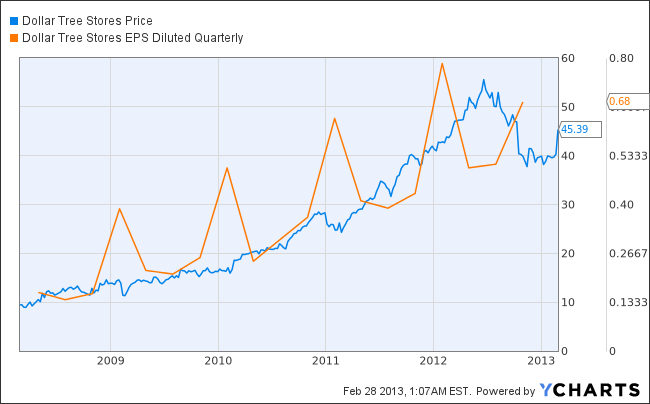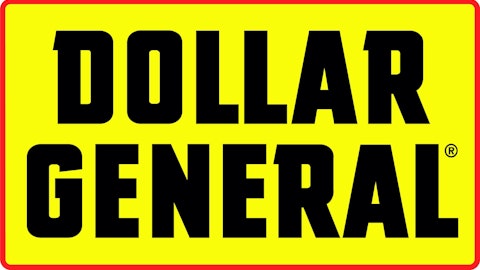As the economy rebounds and consumer’s disposable income appears to be picking up, is there any room left for dollar stores to move higher? Quite possibly. This idea comes as Dollar Tree, Inc. (NASDAQ:DLTR), jumped 10% last week on better than expected earnings results. Dollar Tree has now outpaced other major discount retailers, including Family Dollar Stores, Inc. (NYSE:FDO) and Dollar General Corp. (NYSE:DG), over the last few months.

Driving Dollar Tree up was fourth quarter earnings that were up 26% year over year. The results were robust across the board, sales up 15.4% year over year, comp sales up 2.4% year over year and operating margins expanding 70 basis points to 16.2%.
Dollar Tree has been on a tear over the last five years, seeing its EPS and price steadily grow.

This steady uptrend has led to questions over whether the outperformance can continue. Part of Dollar Tree’s initiatives to keep up its out-performance includes adding frozen and refrigerated foods to its product line, as well as location expansion. However, other major dollar stores appear to be slowing, giving Dollar Tree, Inc. (NASDAQ:DLTR) a possible advantage to take market share and be an attractive opportunity for investors.
Family Dollar Stores, Inc. (NYSE:FDO) saw lower than expected earnings results last quarter, where company management also guided down future earnings. The company’s $0.69 EPS results for last quarter was up only a penny from the same quarter last year. This $0.69 was also on the low end of Family Dollar’s provided guidance of $0.69 to $0.78, due to lower margin products sales that contracted its gross margin around 120 basis points last quarter. Management also expects the gross margin to continue to remain under pressure for 2013; this leading to reduced EPS expectations in the range of $3.95 to $4.20 for 2013, which is down from the previous expected range of $4.10 to $4.40. Dollar General Corp. (NYSE:DG) also recently lowered its full year 2012 guidance, now expecting to post EPS in the range of $2.82 to $2.85, where previous consensus estimates was $2.86.
A couple of other major discount retail competitors include Wal-Mart Stores, Inc. (NYSE:WMT) and Five Below Inc (NASDAQ:FIVE). Wal-Mart posted better than expected earnings last quarter, with EPS of $1.67 per share, compared to $1.51 for the same quarter last year, and above $1.57 consensus. Wal-Mart has been performing relatively well with increased e-commerce investments and better access to international markets (read more about the discount retail’s attack on Wal-Mart). Wal-Mart also upped its annual dividend 18%, now paying $1.88 per share annually and boosting its dividend yield to 2.6%. Five Below is another discount retailer, a specialty one with a focus on merchandise for teen and pre-teen consumers. Five Below’s niche includes products all priced at $5 and below.
So what’s the best way to play discount retail? Dollar General is the location leader, with over 10,000 locations. Family Dollar has around 7,500 and Dollar Tree only 4,600. Meanwhile, Wal-Mart has 8500 locations and Five Below 240. The revenues stack up in a similar fashion, with Dollar General leading the way with $14.8 billion, Family Dollar $9.3 billion and Dollar Tree at $6.6 billion. Despite Dollar Tree’s low-end position, iwth respect to locations and revenue, I see this as an expansion opportunity.
As far as valuation goes…
- Dollar Tree 14.6x
- Family Dollar 12.7x
- Dollar General 13.4x
- Five Below 53x
- Wal-Mart 12x
- Dollar Tree 1.3x
- Family Dollar 0.7x
- Dollar General 0.9x
- Five Below 5x
- Wal-Mart 0.5x
Family Dollar is the cheapest of the three major discount retailers, and Dollar Tree is now the most expensive after its recent run up in stock price. But is the premium valuation warranted? Perhaps. The five year expected EPS growth (according to Wall Street estimates) is:
- Dollar Tree 17%
- Family Dollar 13%
- Dollar General 17%
- Five Below 35%
- Wal-Mart 9%
Dollar Tree also has a leading position in return on investment, versus notable other high growth company Dollar General:
- Dollar Tree 33%
- Family Dollar 22%
- Dollar General 11%
- Five Below 17%
- Wal-Mart 13%
Don’t be fooled. Family Dollar is the only major dollar store paying a dividend yield, one that yields 1.5%. Although Dollar Tree doesn’t currently pay a dividend, it easily could, with $288 million in cash and generating some $687 million in cash flow from operations over the trailing twelve months. Putting a similar payout ratio as Family Dollar’s current dividend on Dollar Tree’s EPS would suggest its dividend yield would be around 1.6%.
A couple top hedge funds were upping their stakes in Dollar Tree during the fourth quarter. Lone Pine Capital boosted its stake over 200%, now Dollar Tree’s top hedge fund owner, and Blue Ridge Capital boosted its stake 40%, now Dollar Tree’s second hedge fund owner (check out all of Dollar Tree’s hedge fund owners).
What’s more is that Dollar Tree is a bit more expensive, but the stock also has very robust growth prospects and impressive return metrics (read more about why Dollar Tree is a bargain). This includes above average returns on investment and returns on equity. Dollar Tree also has the greatest potential with respect to location growth. The industry should be helped by the nicheness of the stores when compared to the likes of Wal-Mart, where Dollar Tree stores are smaller and easily navigated, not to mention lower price points.
The article Are Dollar Stores Still A Growth Story? originally appeared on Fool.com and is written by Marshall Hargrave.
Copyright © 1995 – 2013 The Motley Fool, LLC. All rights reserved. The Motley Fool has a disclosure policy.





